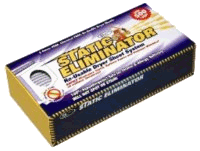The 6+ Synthetic Fabrics You Most Want to Avoid, and Why
by www.SixWise.com
Fabric may not be the first thing that comes to mind when
you think about living a healthier lifestyle, but it definitely
should be considered. Even many "health nuts" don't
realize that synthetic fabrics are teeming with chemicals
and dyes that cannot be washed out, making them a potential
health hazard.
|

Organic, all-natural fabrics like cotton, wool and
linen may be the safest options when it comes to your
health.
|
Toxins in Your Textiles
Most synthetic fabrics, from towels to dress shirts to bed
linens, are treated with chemicals during and after processing.
These chemicals not only leach into the environment, leaving
an impact on groundwater, wildlife, air and soil, but they
also may be absorbed or inhaled directly.
"The use of man-made chemicals is increasing, and
at the same time we have warning signals that a variety
of wildlife and human health problems are becoming more
prevalent," says Dr. Richard Dixon, Head of the World
Wildlife Federation (WWF) Scotland. "It is reckless
to suggest there is no link between the two and give chemicals
the benefit of the doubt. Urgent action is needed to replace
hazardous chemicals with safer alternatives especially in
clothing and other consumer products."
WWF is so concerned about one fairly new clothing additive
that, in 2004, they advised parents to check their children's
clothing labels. If the chemical is on it, they advise switching
to clothing made from natural fibers whenever possible.
Teflon in Your Trousers
The chemicals that the WWF was warning about are perfluorinated
chemicals (PFCs), which include the non-stick additive Teflon.
These chemicals are increasingly being added to clothing because
it makes them last longer and also can make them wrinkle-free.
Most clothing labeled "no-iron" contains PFCs.
The problem with PFcs?
The U.S. Environmental Protection Agency (EPA) says that
PFCs are cancer-causing compounds. However, "no-iron"
and "wrinkle-free" pants have become a popular part
of many schools' compulsory uniforms. Hardly the thing you'd
like to send your child off to school in, but other options
usually aren't provided.
|

PFCs in "wrinkle-free" pants, often used
for school uniforms, may cause cancer, according to
the EPA.
|
"Without knowing it, parents are exposing their children
to toxic chemicals in clothing that could have serious future
consequences for their health and the environment. Children
are usually more vulnerable to the effects of chemicals than
adults, so the presence of these substances in school clothing
is particularly alarming,' says Dr. Dixon.
Your Clothing's Chemical Cocktail
You may be wondering when, and why, chemicals are applied
to your clothing. The fact is, man-made fabrics are complex,
and getting a soft pullover out of raw materials takes some
measure of chemical manipulation. For instance:
-
Chemicals are used to make fibers suitable for spinning
and weaving.
-
A formaldehyde
product is often applied to prevent shrinkage. This product
is applied with heat so it is trapped in the fiber permanently.
-
Petrochemical dyes, which pollute waterways, are used
for color.
-
Chemicals are added to make clothing softer, wrinkle-free,
fire-retardant, moth-repellant and stain-resistant.
-
Commonly used chemicals include volatile
organic compounds (VOCs) and dioxin-producing bleach.
-
Nylon and polyester are made from petrochemicals, whose
production creates nitrous oxide, a greenhouse gas that's
310 times more potent than carbon dioxide.
-
Rayon is made from wood pulp that has been treated with
chemicals, including caustic soda and sulphuric acid.
-
Dye fixatives used in fabrics often come from heavy metals
and pollute water systems.
-
Acrylic fabrics are polycrylonitriles, which may be carcinogenic.
-
Clothing and fabric that is treated with flame-retardant
chemicals, such as children's pajamas, emit formaldehyde
gas.
The chemicals used in synthetic clothing have been linked
to health problems including cancer, immune system damage,
behavioral problems and hormone disruption.
Synthetic Fibers to Avoid
If at all possible, it's best to stay away from the following
fabrics in lieu of more natural options:
- Acrylic
- Polyester
- Rayon
- Acetate
- Triacetate
- Nylon
- Anything labeled static-resistant, wrinkle-resistant,
permanent-press, no-iron, stain-proof or moth-repellant
Natural fabrics tend to breathe better than synthetic fibers
and naturally wick moisture away from the body. These include:
- Cotton
- Linen
- Wool
- Cashmere
- Silk
- Hemp
If you are very sensitive to chemicals, you may want to seek
out organic fabrics. Even natural fabrics, such as cotton,
are treated with pesticides while they are grown, and some
of those pesticides will remain in the fibers. Organic fabrics
are becoming more widely available and can be found in health
food markets, specialty shops and online.
More Safe Clothing Tips
|
Use Static Eliminator for
Soft, Non-Toxic Clothing

Typical dryer sheets are loaded with potentially toxic
chemicals that can be transferred to your clothing.
The Static Eliminator Reusable Dryer Sheet System is
one of the most highly recommended products of all on
SixWise.com because it is:
- Completely Non-Toxic
- Very Economical! Each box is highly effective for
500 loads of laundry!
- 100% Hypoallergenic
- Softens Clothes & Eliminates Static -- without
any harsh toxins
- Safe for Even the Most Delicate Fabrics
- Easier to Use & Reduces Waste -- unlike conventional
dryer sheets
- Won't Clog Up Your Dryer Vents
Learn
more about Static Eliminator
and Order Yours Now!
|
-
Wash and dry synthetic fabrics three times before wearing
them.
-
Do not use conventional
dryer sheets, as they are loaded with toxic chemicals.
An excellent alternative is Static
Eliminator, a reusable dryer sheet system with woven
sheets that take static cling out, and soften fabric without
any toxic chemicals whatsoever.
-
Avoid dry cleaning your clothing, as perchloroethylene,
the chemical most widely used in dry cleaning, is a VOC
known to cause cancer in animals. There are environmentally
friendly dry cleaners that do not use this chemical.
-
Wash your clothing in non-toxic detergent, such as the
EnviroRite
Laundry Detergent, which is non-caustic and free of
petroleum solvents, fragrances and dyes.
Recommended Reading
Volatile
Organic Compounds: The Health Dangers of VOCs, Where They
are Hiding & How to Avoid Them
BEWARE:
Your Fireplace or Wood Burning Stove May Be Harming Your Health
in an Unexpected Way
Sources
Check
School Clothes for Toxic Chemicals
Union
of Concerned Scientists: Dressing Green
Green
Choices: Clothes
The
Environmentalist's New Clothes
The
Chiropractic Journal: Toxic Sleep